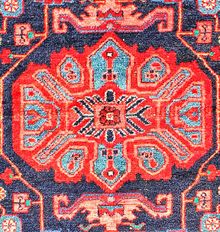Nehavand Rug
| Nehavand Rug | |
|---|---|
 Design of Nahavand Rug (Rugman) | |
| General information | |
| Name | Nahavand Rug |
| Original name | قالی نهاوند |
| Alternative name(s) | Nahavand Carpet (Mosul Rug) |
| Origin | |
| Category | Village |
| Technical information | |
| Common designs | Medallion, Geometric, Herati (Fish) |
| Common colors | Navy Blue, Red, Blue, Beige |
| Dyeing method | Natural, Synthetic |
| Pile material | Wool |
| Foundation material | Cotton |
| Knot type | Symmetrical (Turkish), Asymmetrical (Persian) |
Nahavand is a Persian tribal rug hand-woven rug, made by in Hamadan Province of western Iran. Most of the Nahavands made are about 5 feet by 8 feet. They don't usually come in very large sizes because the weavers use simple horizontal looms on the ground and it is extremely difficult to construct bigger rugs. They feature floral spray designs and geometric patterns, often in a rust or reddish salmon color. The fame of the Nahavand is greatly due to the quality of the wool used to weave it.
History
Nehavand, also spelled Nahavand, is a town located in Hamadan Province of western Iran. Nehavand rugs are known in the market from the early twentieth century. They are categorized as one of the many Hamadan MOSUL RUGS. These Mosul weavings were successfully marketed abroad as competition for the Caucasian and Anatolian (Turkish) rugs of the era. By the last quarter of the twentieth century, some Nehavand weavers switched from making traditional designs in order to create rugs and carpets similar to those of neighboring areas to better satisfy domestic and foreign export consumer demand.[1]
Materials
Foundation and Pile
The rugs have a cotton foundation and a wool pile tied.[2]
Techniques and structures
Color and dyeing
Most rugs have a dark blue color background, but reds or ivory are also used. In addition, blues, reds, browns, camel, gold, and greens are used for the borders and design motifs. Dark blue or dark brown outline the designs.[3]
Motifs and Designs
Nahavand is a source of large rugs with geometricized versions of Sarouk designs. For some rugs, the border design penetrates the field.[4]
Nehavand rugs have semigeometric tribal designs in medallion or allover styles. The motifs include palmettes with leaves and vines, flower heads, and a variety of animals, birds, and human figures. Sometimes primitive tribal design elements are woven into the field and borders.[5]
In villages, designs such a animal head (Kalegi ushvand), boteh leaf, tarikhi, goldastmali (flower band) and borchak are woven in the villages of Ushun, Kalle-Khan, Bonsare, Zar'ain, Ramishan, Khanabad, Noabad, Sardarabad, and Goltapeh possess the ability of weaving finer carpets. In the village of Eynabad, a type of Kharak is woven using Lilian design.[6]
Weaving techniques
Nahavand rugs are single wefted with the symmetric knot on a cotton foundation.[7] Formats range from small mats to rugs in sizes of approximately seven feet by four feet six inches. Occasionally, runners were made in a variety of lengths. The rugs have a Turkish (symmetric) knot. Nehavand weavings generally are woven in grade qualities of good to fine. Early Nehavand rugs measuring approximately four feet by seven feet can have a market value up to $5,000.[8]
See also
Hamadan Rug, Mosul Rug, Sarouk Rug, Lilihan Rug
References
Bibliography
- Abraham Levi Moheban, (2015), The Encyclopedia of Antique Carpets: Twenty-Five Centuries of Weaving, NewYork: Princeton Architectural Press.
- Peter F. Stone, (2013), Oriental Rugs: An Illustrated Lexicon of Motifs, Materials, and Origins Kindle Edition, North Clarendon :Tuttle
- Shirin Souresrafil, (1996), Hamadan Carpet, Tehran: Mina.
- JOZAN: Rug news and antique rugs.